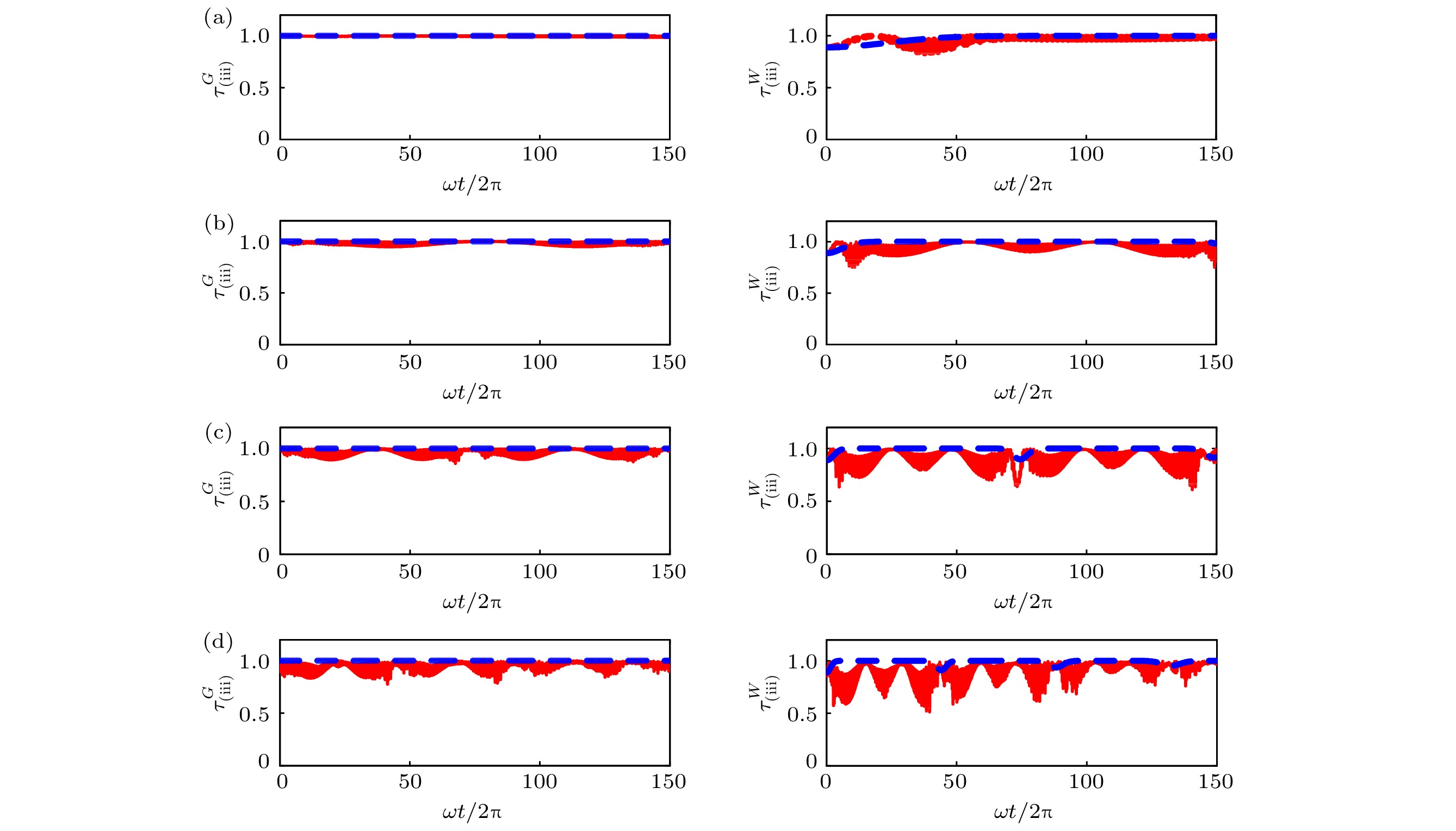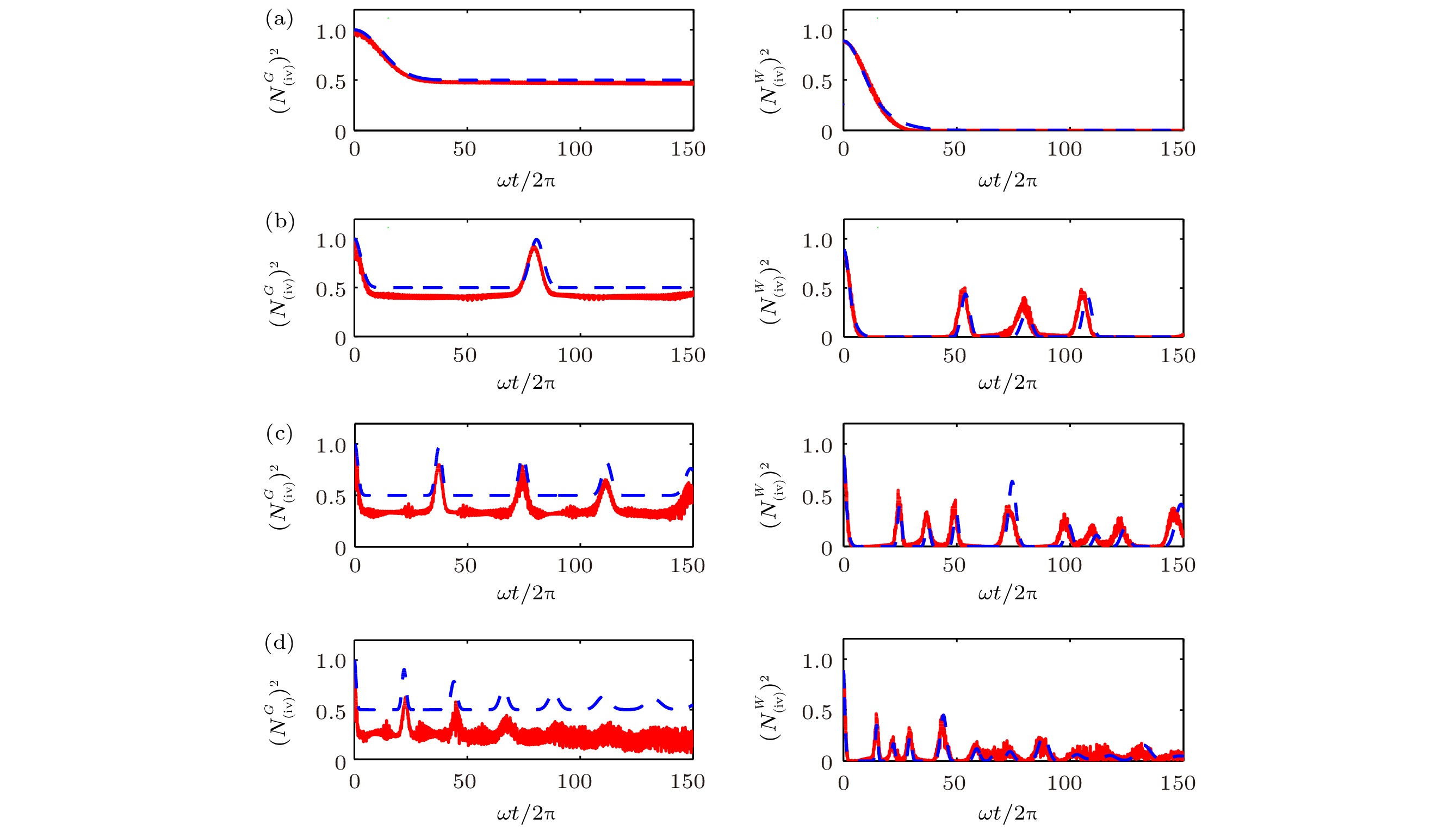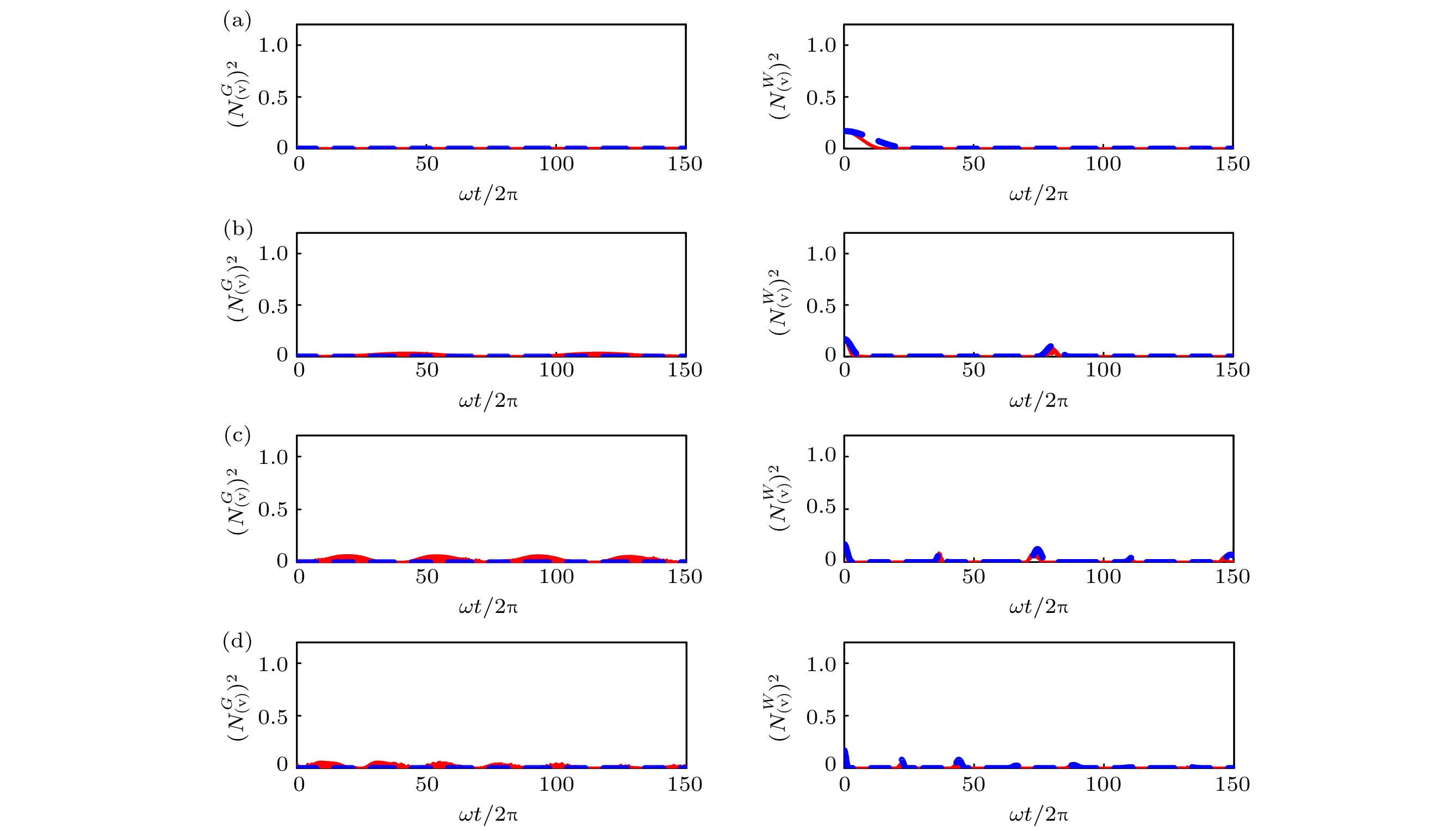-
本文利用绝热近似方法和精确对角化方法研究三量子比特Dicke模型中的纠缠动力学. 处于两种典型的纠缠态GHZ态和W态上的量子比特在时间演化过程中与辐射光场发生强耦合作用, 在各种子系统间产生纠缠, 通过分析这些纠缠的演化特性发现初始GHZ态的三体纠缠鲁棒性比W态强, 这与旋波近似结论一致. 与旋波近似下结果不同的是, 两种态中任意一对量子比特间的纠缠都随时间演化到几乎为零, 而三体纠缠随时间周期演化, 且纠缠程度相对较强, 说明系统中的强耦合作用通过抑制量子比特中的对纠缠来支持三体纠缠.
-
关键词:
- 三量子比特Dicke模型 /
- 对纠缠 /
- 三体纠缠 /
- 鲁棒性
We study the entanglement dynamics of the three-qubit Dicke model by means of the adiabatic approximation and the exact diagonalization in the parameter regime where the qubit transition frequencies are far off-resonance with the radiation field and the interaction strengths reach the ultrastrong-coupling regime. The single-mode field is prepared in the coherent state and two typical states GHZ and W are chosen as the initial three-qubit states. In the process of evolution, the interaction between the quantized field and three-qubit system leads to the generation of entanglement between the field and qubits, as well as between different parties in the three-qubit system, i.e. the pairwise entanglement of two qubits and the tripartite entanglement, which are of ongoing interest in quantum information process. The generalized concurrence and negativity are adopted to quantify different kinds of entanglement. The qubit-field entanglement never reaches the maximum and no sudden death occurs in the the tripartite entanglement for GHZ state, but it is exactly the opposite for W state. This reflects that the tripartite entanglement of the GHZ state is more robust than W sate, which is the same as in the rotating wave approximation. The results beyond the rotating wave approximation show that the pairwise entanglement gradually decreases and vanishes in the evolution of both initial states, with the tripartite entanglement periodically reaching relatively high level. This means that the interaction in system supports the tripartite entanglement at the cost of pairwise entanglement. The conclusions provide theoretical reference for the robustness of entanglement state and quantum information processing using Dicke model.[1] Forn-Díaz P, Lamata L, Rico E, Kono J, Solano E 2019 Rev. Mod. Phys. 91 025005
 Google Scholar
Google Scholar
[2] Ciuti C, Bastard G, Carusotto I 2005 Phys. Rev. B 72 115303
 Google Scholar
Google Scholar
[3] Wallraffff A, Schuster D I, Blais A, Frunzio L, Huang R S, Majer J, Kumar S, Girvin S M, Schoelkopf R J 2004 Nature (London) 431 162
 Google Scholar
Google Scholar
[4] Blais A, Huang R S, Wallraffff A, Girvin S M, Schoelkopf R J 2004 Phys. Rev. A 69 062320
 Google Scholar
Google Scholar
[5] Gu X, Kockum A F, Miranowicz A, Liu Y X, Nori F 2017 Phys. Rep. 718 1
[6] Lv D, An S, Liu Z, Zhang J N, Pedernales J S, Lamata L, Solano E, Kim K 2018 Phys. Rev. X 8 021027
[7] Rabi I I 1936 Phys. Rev. 49 324
 Google Scholar
Google Scholar
[8] Braak D 2011 Phys. Rev. Lett. 107 100401
 Google Scholar
Google Scholar
[9] Liu T, Wang K L, Feng M 2009 Europhys. Lett. 86 54003
 Google Scholar
Google Scholar
[10] Chen Q H, Liu T, Zhang Y Y, Wang K L 2011 Europhys. Lett. 96 14003
 Google Scholar
Google Scholar
[11] He S, Wang C, Chen Q H, Ren X Z, Liu T, Wang K L 2012 Phys. Rev. A 86 033837
 Google Scholar
Google Scholar
[12] Chen Q H, Wang C, He S, Liu T, Wang K L 2012 Phys. Rev. A 86 023822
 Google Scholar
Google Scholar
[13] Hu B L, Zhou H L, Chen S J, Gao X L, Wang K L 2017 J. Phys. A: Math. Theor. 50 074004
 Google Scholar
Google Scholar
[14] Xie W J, Mao B B, Li G Z, Wang W H, Sun C, Wang Y M, You W L, Liu M X 2020 J. Phys. A: Math. Theor. 53 095302
 Google Scholar
Google Scholar
[15] 李志强, 王月明 2019 68 173201
 Google Scholar
Google Scholar
Li Z Q, Wang Y M 2019 Acta Phys. Sin. 68 173201
 Google Scholar
Google Scholar
[16] Dicke R H 1954 Phys. Rev. 93 99
 Google Scholar
Google Scholar
[17] Wang Y K, Hioe F T 1973 Phys. Rev. A 7 831
 Google Scholar
Google Scholar
[18] Emary C, Brandes T 2003 Phys. Rev. E 67 066203
 Google Scholar
Google Scholar
[19] Baumann K, Guerlin C, Brennecke F, Esslinger T 2010 Nature 464 1301
 Google Scholar
Google Scholar
[20] Kirton P, Roses M M, Keeling J, Dalla Torre E G 2019 Adv. Quantum Technol. 2 1800043
 Google Scholar
Google Scholar
[21] Alavirad Y, Lavasani A 2019 Phys. Rev. A 99 043602
 Google Scholar
Google Scholar
[22] Lewis-Swan R J, Safavi-Naini A, Bollinger J J, Rey A M 2019 Nat. Commun. 10 1581
 Google Scholar
Google Scholar
[23] Liu M X, Chesi S, Ying Z J, Chen X S, Luo H G, Lin H Q 2017 Phys. Rev. Lett. 119 220601
 Google Scholar
Google Scholar
[24] 程景, 单传家, 刘继兵, 黄燕霞, 刘堂昆 2018 67 110301
 Google Scholar
Google Scholar
Cheng J, Shan C J, Liu J B, Huang Y X, Liu T K 2018 Acta Phys. Sin. 67 110301
 Google Scholar
Google Scholar
[25] 左战春, 夏云杰 2003 52 2687
 Google Scholar
Google Scholar
Zuo Z C, Xia Y J 2003 Acta Phys. Sin. 52 2687
 Google Scholar
Google Scholar
[26] 郭亮, 梁先庭 2009 58 50
 Google Scholar
Google Scholar
Guo L, Liang X T 2009 Acta Phys. Sin. 58 50
 Google Scholar
Google Scholar
[27] 张国锋, 卜晶晶 2010 59 1462
 Google Scholar
Google Scholar
Zhang G F, Bu J J 2010 Acta Phys. Sin. 59 1462
 Google Scholar
Google Scholar
[28] Youssef M, Metwally N, Obada A S F 2010 J. Phys. B 43 095501
 Google Scholar
Google Scholar
[29] Zhang Y Y, Chen X Y, He S, Chen Q H 2016 Phys. Rev. A 94 012317
 Google Scholar
Google Scholar
[30] Badshah F, Ge G Q, Paternostro M, Qamar S 2020 J. Opt. Soc. Am. B 37 949
 Google Scholar
Google Scholar
[31] Mao L J, Liu Y X, Zhang Y B 2016 Phys. Rev. A 93 052305
 Google Scholar
Google Scholar
[32] Roderick M, Horodecki P, Horodecki R 1998 Phys. Rev. Lett. 80 5239
 Google Scholar
Google Scholar
[33] Coffman V, Kundu J, Wootters W K 2000 Phys. Rev. A 61 052306
 Google Scholar
Google Scholar
[34] Dür W, Vidal G, Cirac J 2000 Phys. Rev. A 62 062314
 Google Scholar
Google Scholar
[35] Ou Y C, Fan H 2007 Phys. Rev. A 75 062308
 Google Scholar
Google Scholar
[36] Dukalski M, Blanter Y M 2013 arXiv 1301.4857
[37] Agarwal S, Hashemi Rafsanjani S M, Eberly J H 2012 Phys. Rev. A 85 043815
 Google Scholar
Google Scholar
[38] Rungta P, Bužek V, Caves C M, Hillery M, Milburn G J 2001 Phys. Rev. A 64 042315
 Google Scholar
Google Scholar
[39] Wootters W K 1998 Phys. Rev. Lett. 80 2245
 Google Scholar
Google Scholar
[40] Zyczkowski K, Horodecki P, Sanpera A, Lewenstein M 1998 Phys. Rev. A 58 883
 Google Scholar
Google Scholar
-
图 1 初始时刻为GHZ态(左)和W态(右)时,
$\left(\rm i \right)$ 类两体纯态纠缠I tangle, 其中红色(实线)表示数值结果, 蓝色(虚线)表示解析结果, 系统参数为$ \omega = 0.15{\omega _{\rm{c}}}$ ,$ z = 3$ ,$g = 0.02{\omega _{\rm{c}}}~\left( {\rm{a}} \right)$ ,$0.04{\omega _{\rm{c}}}~\left(\rm b \right)$ ,$0.06{\omega _{\rm{c}}}~\left(\rm c \right)$ ,$0.08{\omega _{\rm{c}}}~\left(\rm d \right)$ Fig. 1. Time evolution of the I tangle for the type
$\left( \rm i \right)$ with the initial GHZ (left) and W (right) states for$\omega = 0.15{\omega _{\rm{c}}}$ ,$z = 3$ , and different coupling strengths:$g = 0.02{\omega _{\rm{c}}}~\left(\rm a \right)$ ,$0.04{\omega _{\rm{c}}}~\left(\rm b \right)$ ,$0.06{\omega _{\rm{c}}}~\left(\rm c \right)$ ,$0.08{\omega _{\rm{c}}}~\left(\rm d \right)$ , given by the numerical method (solid red line), and the analytical approach (dashed blue line).图 2 初始时刻为GHZ态(左)和W态(右)时,
$\left( {\rm ii} \right)$ 类两体纯态I tangle随时间的演化, 其中红色(实线)表示数值结果, 蓝色(虚线)表示解析结果, 系统参数与图1相同Fig. 2. Time evolution of the I tangle for the type
$\left( {\rm ii} \right)$ with the initial GHZ (left) and W (right) given by the numerical method (solid red line), and the analytical approach (dashed blue line). The corresponding parameters are the same as in Fig. 1.图 3 初始时刻为GHZ态(左)和W态(右)时, (iii) 类两体纯态I tangle随时间的演化, 其中红色(实线)表示数值结果, 蓝色(虚线)表示解析结果, 系统参数与图1相同
Fig. 3. Time evolution of the I tangle for the type (iii) with the initial GHZ (left) and W (right) states given by the numerical method (solid red line), and the analytical approach (dashed blue line). The corresponding parameters are the same as in Fig. 1.
图 4 初始时刻为GHZ(左)态和W(右)态时, (iv)类纠缠负值度的平方随时间的演化, 其中红色(实线)表示数值结果, 蓝色(虚线)表示解析结果, 系统参数与图1相同
Fig. 4. Time evolution of the square of the negativity for the type (iv) with the initial GHZ (left) and W (right) given by the numerical method (solid red line), and the analytical approach (dashed blue line). The corresponding parameters are the same as in Fig. 1.
图 5 初始时刻为GHZ(左)态和W(右)态时, (v) 类对纠缠负值度的平方随时间的演化, 其中红色(实线)表示数值结果, 蓝色(虚线)表示解析结果, 系统参数与图1相同
Fig. 5. Time evolution of the square of the negativity for the type (v) with the initial GHZ (left) and W (right) given by the numerical method (solid red line), and the analytical approach (dashed blue line). The corresponding parameters are the same as in Fig. 1.
图 6 初始时刻为GHZ(左)态和W(右)态时, 真正的三体纠缠π-tangle随时间的演化, 其中红色(实线)表示数值结果, 绿色(实线)表示绝热近似结果, 蓝色(虚线)表示解析结果, 系统参数与图1相同
Fig. 6. Time evolution of π-tanglewith the initial GHZ (left) and W (right) given by the numerical method (solid red line), the adiabatic approximation method (solid green line) and the analytical approach (dashed blue line). The corresponding parameters are the same as in Fig. 1.
-
[1] Forn-Díaz P, Lamata L, Rico E, Kono J, Solano E 2019 Rev. Mod. Phys. 91 025005
 Google Scholar
Google Scholar
[2] Ciuti C, Bastard G, Carusotto I 2005 Phys. Rev. B 72 115303
 Google Scholar
Google Scholar
[3] Wallraffff A, Schuster D I, Blais A, Frunzio L, Huang R S, Majer J, Kumar S, Girvin S M, Schoelkopf R J 2004 Nature (London) 431 162
 Google Scholar
Google Scholar
[4] Blais A, Huang R S, Wallraffff A, Girvin S M, Schoelkopf R J 2004 Phys. Rev. A 69 062320
 Google Scholar
Google Scholar
[5] Gu X, Kockum A F, Miranowicz A, Liu Y X, Nori F 2017 Phys. Rep. 718 1
[6] Lv D, An S, Liu Z, Zhang J N, Pedernales J S, Lamata L, Solano E, Kim K 2018 Phys. Rev. X 8 021027
[7] Rabi I I 1936 Phys. Rev. 49 324
 Google Scholar
Google Scholar
[8] Braak D 2011 Phys. Rev. Lett. 107 100401
 Google Scholar
Google Scholar
[9] Liu T, Wang K L, Feng M 2009 Europhys. Lett. 86 54003
 Google Scholar
Google Scholar
[10] Chen Q H, Liu T, Zhang Y Y, Wang K L 2011 Europhys. Lett. 96 14003
 Google Scholar
Google Scholar
[11] He S, Wang C, Chen Q H, Ren X Z, Liu T, Wang K L 2012 Phys. Rev. A 86 033837
 Google Scholar
Google Scholar
[12] Chen Q H, Wang C, He S, Liu T, Wang K L 2012 Phys. Rev. A 86 023822
 Google Scholar
Google Scholar
[13] Hu B L, Zhou H L, Chen S J, Gao X L, Wang K L 2017 J. Phys. A: Math. Theor. 50 074004
 Google Scholar
Google Scholar
[14] Xie W J, Mao B B, Li G Z, Wang W H, Sun C, Wang Y M, You W L, Liu M X 2020 J. Phys. A: Math. Theor. 53 095302
 Google Scholar
Google Scholar
[15] 李志强, 王月明 2019 68 173201
 Google Scholar
Google Scholar
Li Z Q, Wang Y M 2019 Acta Phys. Sin. 68 173201
 Google Scholar
Google Scholar
[16] Dicke R H 1954 Phys. Rev. 93 99
 Google Scholar
Google Scholar
[17] Wang Y K, Hioe F T 1973 Phys. Rev. A 7 831
 Google Scholar
Google Scholar
[18] Emary C, Brandes T 2003 Phys. Rev. E 67 066203
 Google Scholar
Google Scholar
[19] Baumann K, Guerlin C, Brennecke F, Esslinger T 2010 Nature 464 1301
 Google Scholar
Google Scholar
[20] Kirton P, Roses M M, Keeling J, Dalla Torre E G 2019 Adv. Quantum Technol. 2 1800043
 Google Scholar
Google Scholar
[21] Alavirad Y, Lavasani A 2019 Phys. Rev. A 99 043602
 Google Scholar
Google Scholar
[22] Lewis-Swan R J, Safavi-Naini A, Bollinger J J, Rey A M 2019 Nat. Commun. 10 1581
 Google Scholar
Google Scholar
[23] Liu M X, Chesi S, Ying Z J, Chen X S, Luo H G, Lin H Q 2017 Phys. Rev. Lett. 119 220601
 Google Scholar
Google Scholar
[24] 程景, 单传家, 刘继兵, 黄燕霞, 刘堂昆 2018 67 110301
 Google Scholar
Google Scholar
Cheng J, Shan C J, Liu J B, Huang Y X, Liu T K 2018 Acta Phys. Sin. 67 110301
 Google Scholar
Google Scholar
[25] 左战春, 夏云杰 2003 52 2687
 Google Scholar
Google Scholar
Zuo Z C, Xia Y J 2003 Acta Phys. Sin. 52 2687
 Google Scholar
Google Scholar
[26] 郭亮, 梁先庭 2009 58 50
 Google Scholar
Google Scholar
Guo L, Liang X T 2009 Acta Phys. Sin. 58 50
 Google Scholar
Google Scholar
[27] 张国锋, 卜晶晶 2010 59 1462
 Google Scholar
Google Scholar
Zhang G F, Bu J J 2010 Acta Phys. Sin. 59 1462
 Google Scholar
Google Scholar
[28] Youssef M, Metwally N, Obada A S F 2010 J. Phys. B 43 095501
 Google Scholar
Google Scholar
[29] Zhang Y Y, Chen X Y, He S, Chen Q H 2016 Phys. Rev. A 94 012317
 Google Scholar
Google Scholar
[30] Badshah F, Ge G Q, Paternostro M, Qamar S 2020 J. Opt. Soc. Am. B 37 949
 Google Scholar
Google Scholar
[31] Mao L J, Liu Y X, Zhang Y B 2016 Phys. Rev. A 93 052305
 Google Scholar
Google Scholar
[32] Roderick M, Horodecki P, Horodecki R 1998 Phys. Rev. Lett. 80 5239
 Google Scholar
Google Scholar
[33] Coffman V, Kundu J, Wootters W K 2000 Phys. Rev. A 61 052306
 Google Scholar
Google Scholar
[34] Dür W, Vidal G, Cirac J 2000 Phys. Rev. A 62 062314
 Google Scholar
Google Scholar
[35] Ou Y C, Fan H 2007 Phys. Rev. A 75 062308
 Google Scholar
Google Scholar
[36] Dukalski M, Blanter Y M 2013 arXiv 1301.4857
[37] Agarwal S, Hashemi Rafsanjani S M, Eberly J H 2012 Phys. Rev. A 85 043815
 Google Scholar
Google Scholar
[38] Rungta P, Bužek V, Caves C M, Hillery M, Milburn G J 2001 Phys. Rev. A 64 042315
 Google Scholar
Google Scholar
[39] Wootters W K 1998 Phys. Rev. Lett. 80 2245
 Google Scholar
Google Scholar
[40] Zyczkowski K, Horodecki P, Sanpera A, Lewenstein M 1998 Phys. Rev. A 58 883
 Google Scholar
Google Scholar
计量
- 文章访问数: 7590
- PDF下载量: 153
- 被引次数: 0




























 下载:
下载:







